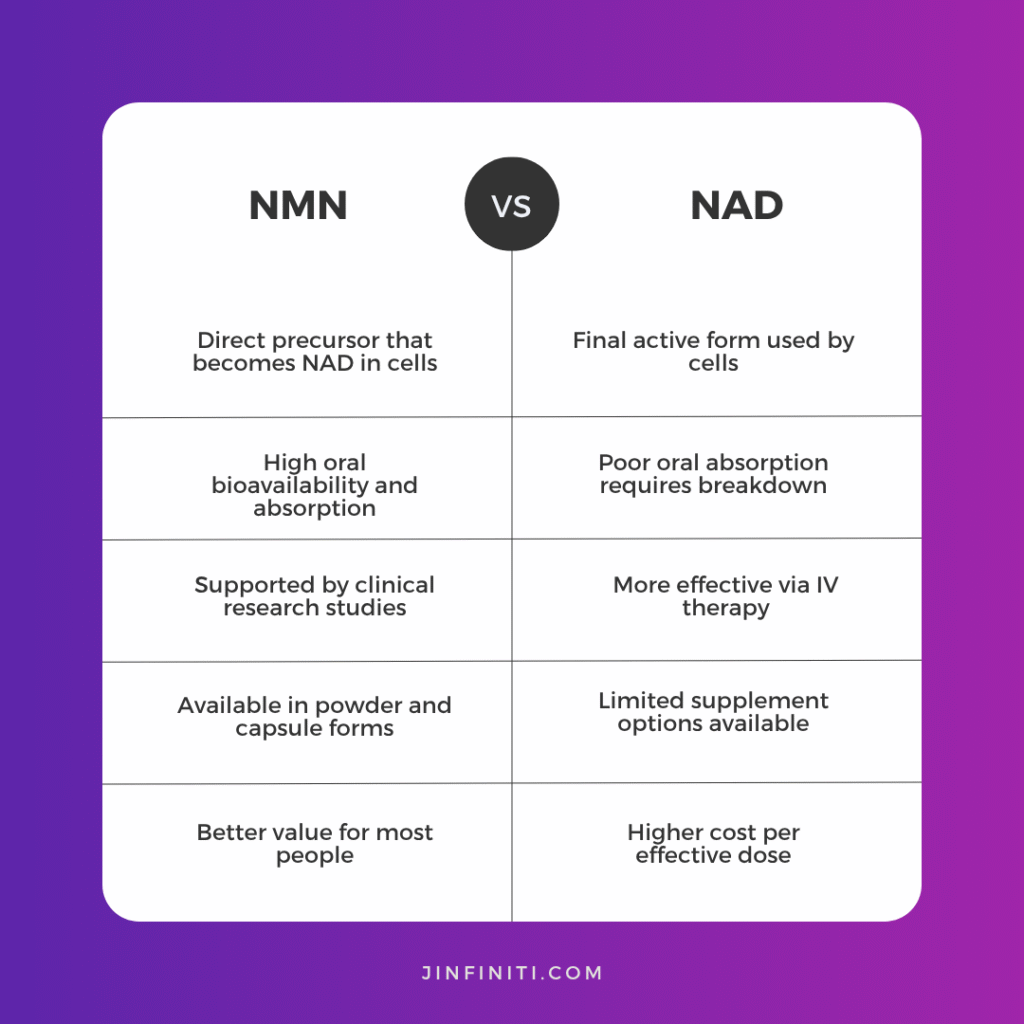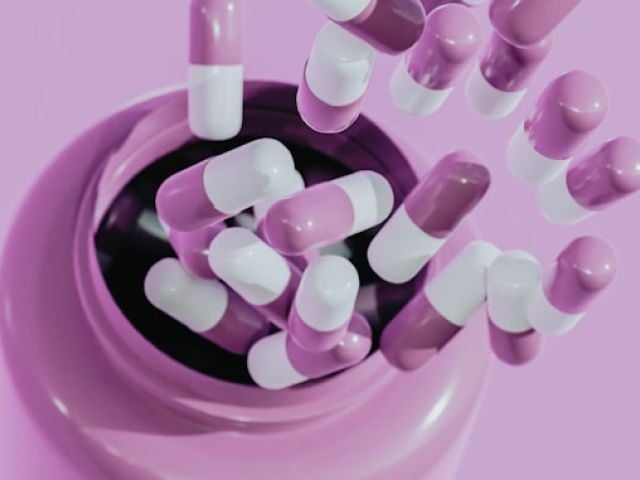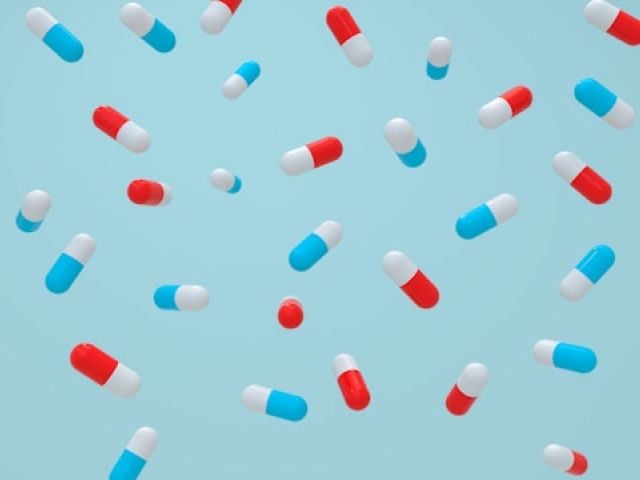
What’s the Difference Between NMN vs NAD?
You’ve probably heard about NAD and NMN in health circles. Both molecules get mentioned together often. This sometimes creates confusion about their relationship.
Both molecules work closely together in your cells. But they have different roles and characteristics.
Let’s break down what each molecule does. You’ll learn how NMN and NAD work and why it matters for your health.
Key Takeaways
- NMN offers superior bioavailability compared to direct NAD supplementation for oral use.
- NMN converts directly to NAD through the enzyme NMN adenylyltransferase in your cells.
- Testing your baseline NAD levels helps personalize supplementation for optimal results.
- Both molecules support cellular energy, DNA repair, and healthy aging processes.
How NMN and NAD Work at the Cellular Level
These molecules play connected but distinct roles in cellular function.
What is NMN?
NMN stands for nicotinamide mononucleotide. It’s a precursor to NAD that your body uses to make the essential coenzyme.
You can find tiny amounts in foods like broccoli and avocados. The concentrations are too low to provide therapeutic benefits through diet alone.
NMN has three main parts: phosphate, ribose sugar, and nicotinamide1. This structure allows easy cell entry and conversion into NAD.
What is NAD?
NAD is short for nicotinamide adenine dinucleotide. It’s a coenzyme that powers over 500 cellular reactions.
Your mitochondria (cellular powerhouses) depend on NAD for energy production. It acts like a shuttle that carries electrons between reactions.
NAD exists in two forms. NAD+ accepts electrons. NADH donates them back to fuel cellular processes.
This electron transfer system powers your cells. It supports DNA repair, gene expression, and cellular signaling pathways.
The Differences Between NMN and NAD
The main distinctions affect how your body processes and uses them.
Size and Structure
NMN is significantly smaller than NAD. It weighs about 334 grams per mole2. NAD weighs approximately 663 grams per mole.
This size difference matters. Smaller molecules typically cross cell membranes more easily.
NAD’s larger structure makes direct cell absorption harder.
How Your Body Absorbs Them
Your digestive system handles these molecules differently:
NMN Absorption:
- Enters bloodstream within minutes3
- Uses specific intestinal transporters
- Reaches tissues in 10-30 minutes
- Stays intact during transport
NAD Absorption:
- Cannot cross cell membranes intact4
- Gets broken down before absorption
- Requires cellular reassembly
- Less efficient for oral use

How NMN Converts Into NAD
NMN is converted to NAD through a direct cellular pathway.
The Conversion Process
Once NMN enters cells, the enzyme NMN adenylyltransferase converts it directly into NAD1. This happens through the “salvage pathway.”
Your cells prefer this efficient route. It requires fewer steps than other NAD precursors.
The process maintains steady NAD levels in your cellular environment.
Why Cellular NAD Levels Decline
Your NAD naturally decreases with age. By age 50, you typically have half the levels of NAD you had at 20.
Several factors contribute to this decline:
- Increased cellular repair demands
- Reduced precursor production
- Higher enzyme activity that consumes NAD
- Accumulated cellular damage
NAD deficiency symptoms become more common as levels drop.
Benefits of NAD and NMN Supplements

Both support similar outcomes because NMN becomes NAD in your cells.
Shared Health Benefits
Research shows that boosting NAD levels may support:
Energy and Metabolism:
- Better mitochondrial function
- Improved cellular energy production
- Enhanced glucose metabolism
- Healthy weight management support
Cellular Health and Longevity:
- DNA repair processes
- Better cellular signaling
- Protection against oxidative stress
- Support for overall cellular health and aging
Benefits of NMN Supplementation
Clinical studies show promising results. Participants taking 300-900mg daily for 60 days increased blood NAD levels5.
They also showed improved physical performance. Research indicates NMN may help insulin sensitivity in prediabetic individuals6.
Animal studies suggest NMN supports healthy aging. It improves energy metabolism and mitochondrial function.
Athletes taking NMN have also shown improved aerobic exercise capacity7 and recovery. NMN acts to support mitochondrial efficiency which is important for athletic performance.
People over 40 typically see the most benefits from NAD supplementation. Supporting cellular function becomes more important as natural production declines.
NMN vs NAD: Which Should You Choose?

Evidence suggests NMN offers advantages for oral supplementation compared to taking NAD directly.
Bioavailability Comparison
| Factor | NMN | NAD |
|---|---|---|
| Absorption | High | Limited |
| Cell transport | Direct | Requires breakdown |
| Conversion efficiency | Excellent | Variable |
| Oral effectiveness | Strong | Moderate |
Cost and Practical Considerations
An NMN supplement typically costs less than direct NAD products. Manufacturing stable, bioavailable NAD requires more complex processes.
You’ll also find more NMN supplement options available. Quality varies between brands, so choosing products with third-party testing matters.
For optimal results, consider Jinfiniti’s Vitality NAD+ Booster. Our science-backed formulation combines NMN with energy-boosting compounds that work together to replenish NAD stores.
Should You Take NMN and NAD Together?
Taking both simultaneously usually isn’t necessary. NMN converts into NAD naturally.
Most people benefit more from quality supplements like NMN for health and well-being. Your cells will convert the NMN into the NAD they need for optimal health.
Some practitioners recommend NAD supplements for specific purposes. These are often administered through IV therapy rather than oral supplements.
Before starting any new supplement regimen, consult healthcare providers familiar with NAD metabolism.
Choosing Quality NAD Supplements
Quality matters significantly when selecting products. Here’s what to look for:
Purity Standards:
- Third-party contamination testing
- Available certificates of analysis
- Certified manufacturing facilities
- Proper storage protocols
Formulation Quality:
- Pharmaceutical-grade ingredients
- Appropriate dosing per serving
- Complementary absorption compounds
- Stable, bioavailable forms
Testing Your Progress
The most accurate evaluation method is direct testing. Testing your NAD levels provides objective data about cellular function.
Our at-home Intracellular NAD Test measures actual cellular NAD concentrations. This is the world’s first test of its kind that can be conveniently taken wherever you are.
This follows Jinfiniti founder Dr. Jin-Xiong She’s “Test, Act, Optimize” methodology. Establish baseline levels. Implement targeted supplementation. Retest to confirm improvements.
Natural Ways to Boost NAD Levels
Lifestyle strategies can also support raising NAD levels naturally alongside supplementation.
Dietary Approaches
Foods rich in NAD precursors help support baseline levels:
- Fish like salmon and tuna
- Mushrooms and green vegetables
- Whole grains and legumes
- Natural NMN food sources
Lifestyle Factors
- Exercise: Regular activity stimulates NAD-producing enzymes. It also supports mitochondrial health.
- Sleep: Quality sleep allows cellular repair. It helps regenerate NAD stores effectively.
- Stress Management: Chronic stress depletes NAD reserves. Managing stress supports healthy levels.
- Intermittent Fasting: Research suggests fasting periods may naturally boost NAD levels through metabolic pathways.
Effects of NMN Supplementation: What to Expect
NMN typically produces gradual improvements over several weeks.
Timeline of Benefits
Week 1-2:
- Possible mild digestive adjustment
- Subtle energy improvements
- Better sleep quality for some
Week 3-4:
- More noticeable energy increases
- Improved exercise recovery
- Enhanced mental clarity
Month 2-3:
- Sustained energy improvements
- Better metabolic function
- Improved physical performance markers
Individual responses vary based on baseline NAD levels and overall health status.
Safety Profile: NAD vs NMN

Both molecules appear safe for healthy adults at recommended doses.
Common Side Effects
Use of NMN supplementation may cause mild, temporary effects:
- Slight digestive upset when starting
- Occasional headaches during first week
- Mild fatigue as cellular processes adjust
Research shows NMN may be safe at doses up to 900mg daily3 for extended periods.
Special Considerations
- Cancer History: Consult oncologists before beginning supplementation.
- Medication Interactions: NAD supplements may interact with blood sugar medications.
- Pregnancy: Limited safety data exists. Avoiding supplementation is recommended.
Dosing Guidelines for Effective Results
Research supports specific dosing ranges for NMN supplementation.
Recommended Doses
| Goal | NMN Dose Range | Timing |
|---|---|---|
| General health | 250-500mg daily | Morning |
| Performance support | 500-750mg daily | Pre-workout |
| Aging support | 500-900mg daily | Split doses |
Start with lower doses. Gradually increase based on tolerance.
Clinical studies show benefits beginning around 250mg daily3. Higher doses may provide additional benefits for some people.
Timing Strategies
Take NMN supplements in the morning to align with natural rhythms. Your body’s NAD metabolism follows daily cycles.
Peak activity occurs during daylight hours. Some people benefit from splitting larger doses throughout the day.
Monitor your energy and sleep patterns. This helps find optimal timing for your needs.
Making Your Decision: A Summary
For most people seeking cellular health support, NMN offers practical advantages.
NMN provides superior bioavailability and research support. Its ability to cross cell membranes efficiently makes it preferred for oral use.
Cost-effectiveness also favors NMN over direct NAD products. You get more value for your investment.
Direct NAD administration through IV therapy may benefit severe deficiency cases. Some medical conditions requiring rapid replenishment might warrant this approach.
Work with qualified healthcare providers for IV treatments.
Your Path to Better Cellular Health
NMN offers practical advantages for most people due to superior absorption. The research supporting NMN provides compelling evidence for maintaining cellular energy.
Whether you choose supplementation, lifestyle interventions, or both, supporting cellular energy systems can maintain vitality and optimal health as you age.
Work with knowledgeable healthcare providers who understand NAD metabolism. They can guide your strategy based on your individual health profile.
Testing your current NAD levels provides the best starting point. This data-driven approach ensures you’re addressing your actual needs rather than guessing.
Referenced Sources
- https://pmc.ncbi.nlm.nih.gov/articles/PMC7238909/ ↩︎
- https://pmc.ncbi.nlm.nih.gov/articles/PMC7198709/ ↩︎
- https://pmc.ncbi.nlm.nih.gov/articles/PMC5668137/ ↩︎
- https://pmc.ncbi.nlm.nih.gov/articles/PMC8612620/ ↩︎
- https://link.springer.com/article/10.1007/s11357-022-00705-1 ↩︎
- https://pmc.ncbi.nlm.nih.gov/articles/PMC10240123/ ↩︎
- https://www.tandfonline.com/doi/10.1186/s12970-021-00442-4 ↩︎

Get weekly health insights and exclusive offers by joining our newsletter.











